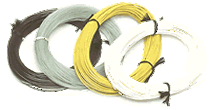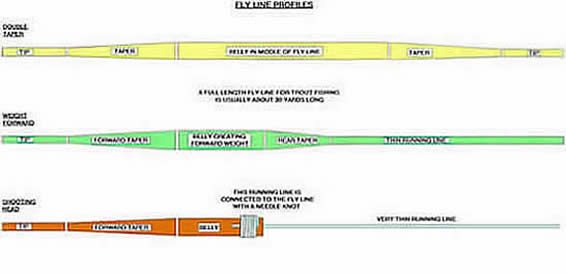Fly Lines |
The Basics of choosing a Fly Line (Single Handed Rods) |
Choosing a fly line can be a very complicated affair indeed, and it can dictate whether or not your fly fishing outfit is balanced correctly. It is also critical to the performance of your outfit from the outset.
The following information is a basic guide only to help you understand a ballanced outfit
|

There are many different types of fly lines on the market today that will just about cover every situation you will encounter whilst fishing. Lines with such fancy names as Double Tapers, Weight Forwards, (Forward Tapers) and Shooting Heads, (to name but a few). Then just to further complicate things, they will all have different densities, there will be Floating Lines, Neutral Densities, Intermediates, Fast Sinking, Ultra Fast Sinking, Hi D's, "LET'S STOP RIGHT THERE". When you are first learning how to cast correctly, all you want to do, is make things as easy for yourself as possible. So the obvious choice must therefore be a floating line, simply because, as it's name suggests, it will float on the top of the water, making it much easier to lift off again when practicing your casting. Obviously, as you improve, (and especially when fish become a factor) there will be other considerations to be made, but not just yet!
When selecting your floating line, you will notice the letters A.F.T.M. on the packaging, (Association of Fishing Tackle Manufacturers) or a small hash mark, rather like a naught's and crosses sign #, or maybe even both. This will be followed by a number. It is this number that is important to you, as it indicates which fly line will balance your fly rod correctly. Check your fly rod (before going for your new line) for one of these indicators. They are usually found on the rod blank just above the cork handle, and will be followed by the aforementioned number. This number should be matched to the number on the fly line box you are purchasing, and therefore give you the Association of Fishing Tackle Manufacturers recommended line rating for that particular rod and ultimately the suggested formula to create your balanced outfit.
|
If your fly rod displays more than one number, let's say 6/7, this indicates that your rod can be loaded with either a size 6 Double Taper line or a size 7 Weight Forward line. If rated correctly, the Weight Forward line (WF7) will have the required casting weight within its relevant head length at the front of your fly line, (profiles will differ). The head of a fly line consists of a front taper, a belly and a back taper. (see diagram below). When this head is placed just outside the rod tip, or sometimes with the back taper just inside the rod tip, it will perform well. If you experiment with this position whilst casting you will find what is often referred to in casting as the sweet spot, and you will often benefit from the result.
However, the Double Taper line, (DT6) referred to here, has a lower rating, e.g. (6) which should (if rated correctly) make the first 10 yards of this line lighter than the (7) weight line, but because of its profile the (DT) line can be extended further in the air more efficiently than the weight forward line when casting, allowing you to add extra weight to this line, simply because you are carrying more line in the air. This in turn will also allow you to load the rod more efficiently as you have now effectively made your size 6 Double Taper line heavier and more in line with the higher rating shown on your rod i.e. a (7) weight line. You are able to achieve this because the longer belly section (the thick bit) (see diagram below) of a double taper line allows you to maintain control over this line in the air, whereas this cannot be done as well with a Weight Forward line, as the thin running line will not turn over the thicker belly section of the line as efficiently when extended too far outside the rod tip, and line control then becomes an issue (except when using advanced casting techniques). However, if in doubt when first starting out in fly fishing, always opt for the higher rating displayed on your rod when buying your fly line.
|
The fancy names we discussed earlier are not as complicated as they may sound once they are explained. A Double Taper for instance is exactly what the name implies, it generally consists of about 30yds (approx. 27.5metres) of fly line, with a tapered section at each end, the middle section is thicker, and is known as the belly of the line. This thicker section will assist with control in the air whilst carrying longer lines whilst still maintaining a good transfer of energy to the thinner front taper when casting, assisting with turnover and presentation of your fly. As an added bonus you can also reverse a Double Taper line on your reel if one end becomes damaged. A Weight Forward line is a good line to achieve much longer distances for less effort (head lengths will differ depending on the application it will be required for) and it will generally be a big advantage when Spey casting too. Once again the clue is in the name, "Weight - forward", which simply means, that the casting weight, concentrated mainly in the belly of the line, but also includes the front and back tapers, is all at the front, unlike the DT line where the weight is distributed throughout. So what this means, is that with this particular line you have the rear taper, the belly, the front taper and the tip all concentrated within the front section of your fly line, collectively known as the head. By making sure that the rear taper of your fly line is (for now) just inside your tip ring when casting, (especially when Roll casting) you will find you have much more control over the head of your fly line, and the narrow line behind the head (the running line) will offer much less resistance when passing through your rod rings during casting, therefore often affording you more distance for less effort. As mentioned earlier, try to avoid having too much of this thin running line outside your rod tip when casting, as this line will not turn over the heavier belly very well and the cast will collapse, especially into an oncoming wind, this is a common mistake and can cause big problems, especially when roll casting, although this can be overcome in certain situations when using advanced casting techniques such as hauling. When you move on to the Spey Casting techniques, a certain amount of this narrow line outside your rod tip will give you a distinct advantage at times, and as previously discussed is often referred to a discovering the sweet spot. Weight forward lines will also allow you to introduce more backing line onto your reel, (where required) due to its thinner profile over most of its length. less effort (head lengths will differ depending on the application it will be required for) and it will generally be a big advantage when Spey casting too. Once again the clue is in the name, "Weight - forward", which simply means, that the casting weight, concentrated mainly in the belly of the line, but also includes the front and back tapers, is all at the front, unlike the DT line where the weight is distributed throughout. So what this means, is that with this particular line you have the rear taper, the belly, the front taper and the tip all concentrated within the front section of your fly line, collectively known as the head. By making sure that the rear taper of your fly line is (for now) just inside your tip ring when casting, (especially when Roll casting) you will find you have much more control over the head of your fly line, and the narrow line behind the head (the running line) will offer much less resistance when passing through your rod rings during casting, therefore often affording you more distance for less effort. As mentioned earlier, try to avoid having too much of this thin running line outside your rod tip when casting, as this line will not turn over the heavier belly very well and the cast will collapse, especially into an oncoming wind, this is a common mistake and can cause big problems, especially when roll casting, although this can be overcome in certain situations when using advanced casting techniques such as hauling. When you move on to the Spey Casting techniques, a certain amount of this narrow line outside your rod tip will give you a distinct advantage at times, and as previously discussed is often referred to a discovering the sweet spot. Weight forward lines will also allow you to introduce more backing line onto your reel, (where required) due to its thinner profile over most of its length.
|
Shooting Heads are simply an extreme version of a Weight Forward line, and home made versions may simply consist of a belly and front taper only (with tip), which is attached directly to an extremely thin running line and can be cast very long distances when executed correctly, but as these home made heads will often have no rear taper to control the cast, it can cause all sorts of problems if poor technique is applied. However, don’t discard your old fly lines, as you can make up your own shooting heads from them. There are many profiles of shooting heads available on the market today and unlike the home made versions discussed above, they will incorporate a short back taper which will afford you more control over the head making it more stable and efficient to cast. |
As your casting improves and your fishing diversifies, it may be worth purchasing a Sinking line for your armouryThere are many different sinking lines on the market with a variety of sink rates available, depending on how deep you want to fish, but help is always available if unsure. Remember, even when buying a sinking line, that the same rules apply, match the rating on your rod to the rating on the fly line you are purchasing, this applies to both Double Taper and Weight Forward lines alike. |
Although fly line profiles can differ enormously these days, you will notice in the diagram, that I have made the profiles of the first 10yds of all the basic fly lines shown, exactly the same, i.e. Belly, Forward Taper and Tip. It is only the profile behind these sections that distinguish the lines from each other. The diagram is therefore only designed as an example of the different fly lines discussed above. Click on Diagram for Enlargement. |
|
|
